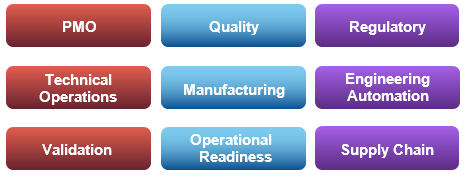Technology Transfers: Critical To Medicine Mobilization, Success & Sustainability
By Nick Casale, Tony Khoury, Jim Watson, and Cory Proctor

The technology transfer process is the critical and inevitable step in moving science forward for promising and, eventually, successful products. When an innovative device or drug product has shown promise in the research and discovery phase, the process needs to be further developed for clinical, then commercial, production to reach the patients who need it. Often, this means the process must be transferred to a new site that can accommodate further development and scale-up, have the capacity to support the clinical and commercial phases of a product, and comply with the cGMP requirements. When executed properly in a truly collaborative team approach, this transition can be successful, resulting in uneventful manufacturing.
There are several common scenarios that would require the technology transfer of a product:
- An academic or research setting might outsource production to a contract development manufacturing organization (CDMO)
- A product transfer between two sites within one organization
- A transfer from a CDMO to another external manufacturing site
Typically, in the academic setting, technology transfer is driven by the need for cGMP compliance along with further product scale-up. Additionally, the academic setting has challenges, including lack of infrastructure, equipment, or enough capacity. When the R&D process is complete and the product is ready for the next step in commercialization, that process is often outsourced to a trusted CDMO to bring the innovation to life. The technology transfer process is put in place to help define the goals, needs, and timeline and to ensure that no vital process steps are misconstrued between sites. These are critical to the outcomes and success of the product.
The need for manufacturing companies to transfer their products is often driven by product supply chain expansion, market needs, distribution strategies, and risk mitigation. Companies that have the capacity to manufacture their products will transfer or outsource the process to allow for dual sourcing of critical products and/or increase capacity in their facility. In some cases, a company will transfer its process because of the results of an efficiency evaluation or to reduce redundancies within the organization. For example, this could occur when an internal global program scales down manufacturing sites or after there is a company acquisition.
A manufacturing transfer between internal sites looks remarkably similar to moving a process to or from a CDMO to another manufacturing site and is nearly identical from a technical perspective. The internal transfer may be governed by a larger global quality system, which will replace the need for a quality agreement or auditing to be in place or take place. The global quality system should take care of that.
Tech Transfer Prechecks
When preparing for the tech transfer process, there are several assessments that should be completed prior to choosing the new site. The most critical piece of the evaluation is a facility and infrastructure suitability assessment. This measure will ensure that the site has the manufacturing platform technologies required to make your product or drug and assess the facility’s testing capabilities for product release.
The CDMO precheck checklist should cover:
- Is the CDMO approved in the client system as a CDMO provider?
- Has the CDMO been audited?
- Is there a quality agreement in place?
- Is there a commercial agreement in place?
- Are they currently providing similar platform services?
- Other general considerations are: quality management systems, non-conformances, corrective actions and preventive actions, process-related questions, organizational structure, process and infrastructure support equipment, etc.
In addition to understanding the facility’s capacity and capabilities, the site’s programs and procedures should be investigated to determine if it has a proven track record of success in the industry. If you are deciding on a CDMO, check to see if it has been audited and what the outcomes were. Choosing a credible, reliable team and facility to take over your production process is just as important as the facility’s infrastructure.
Project Kickoff: Establishing Teams’ Roles & Responsibilities
When engaging with an outside organization, the first and most important step is to ensure that there is complete alignment on the tech transfer charter, scope, goals, budget, and schedule. In the case of an established site transferring to a CDMO, respective workstream leads from the sending and receiving sites should identify team structures, roles, and responsibilities early on. This process will pave the way for a smooth and efficient partnership. Utilizing a responsible, accountable, consulted, and informed (RACI) chart can help clearly document the roles and responsibilities across your functional teams. Additionally, having a clear understanding of the stakeholders and how the project team should communicate to them is key.
Technology Transfer Team Playbook
Each team on the sending and receiving site needs to be fully aligned on their roles and responsibilities within the process. Below, you will find a list of potential departments responsible for the key deliverables of each workstream within the organization.
Workstream Swim Lanes

Key deliverables for each workstream should include regulatory filings, supply chain plans for transportation and cold chains, and quality systems management. Operational readiness should assess if the suite is ready for client operations, and manufacturing would direct training of personnel and batch record readiness. Additional deliverables expected from each workstream consist of:
- Engineering automation: technical specifications (user requirement, functional requirement, and data distribution specifications)Validation: validation master plan/project plan, system impact assessment
- Technical operations: Kanban planning
- Project management office (PMO): project management services, define, measure, analyze, improve, and control (DMAIC) planning, operational excellence, tools for project management
- Manufacturing: batch records ready for use, personnel trained
Key Takeaways
In every new partnership, up-front alignment among key stakeholders is critical to success. By establishing site-to-site collaboration, an agreed-upon scope, and a well thought out strategy for each critical workstream, the tech transfer process can be a seamless transition between organizations. Misalignment or deviation from the plan may have a negative impact on the supply chain, can damage partner relationships, and ultimately puts the success of your product and the patient at risk.
It is critically important to evaluate each workstream thoroughly and perform regular in-depth technical reviews. The sending and receiving sites should establish a plan early; it is helpful to reuse strategies for processes that have already completed as a template and leverage this information to the team’s advantage. Break out the plan by each organizational area that rolls up into the project management office tech transfer plan for staffing, training, and mapping. There is no need to reinvent the wheel when there is an existing system or strategy that is proven and effective.
Schedule regular recurring meetings to maintain communication between stakeholders and respective workstream leads. Both the sending and receiving sites must be responsible for flagging risks, identifying potential roadblocks, and creating solutions. Ensure the plan is readily available and shared according to the roles and responsibilities outlined in the RACI. Continuous review and improvement of the strategy are just as important as establishing it in the first place. The success of the product depends upon the sending and receiving sites working together. Remind the teams that this partnership is critical to the sites’ productivity and the ultimate end goal of providing lifesaving medication to the patients who need them.
About The Authors:
Nick Casale is currently VP of technical operations at Amicus Therapeutics, leading their commercial biologics and gene therapy manufacturing strategy and value chain risk management. He began his career in engineering and technical operations at Johnson & Johnson, leading technical organizations in the manufacturing and supply of a wide range of pharmaceutical and biologic products. Over his 29-year career, he has held positions of increasing responsibility in manufacturing, technical operations, and engineering at several major biopharmaceutical companies, including Novartis, Brammer Bio LLC (Thermo Fisher Viral Vector Services), Biogen, and Bausch & Lomb Pharmaceuticals.
Tony Khoury is an EVP and a member of Project Farma’s leadership committee. He spearheaded Project Farma’s growth in the gene and cell therapy space. He has extensive experience with small and large molecules, including solid oral dosage, biologics, biosimilars, and gene and cell therapies. Khoury has worked with small and large biotech and pharmaceutical companies, including gene and cell therapy startups and CMOs/CROs. He has led global programs greater than $350+ million in the following disciplines: project management, turnkey facility builds, automation, validation, engineering, and serialization track and trace.
Jim Watson is a VP at Project Farma, has led development of Project Farma’s presence in the East Coast, and has been a leader on its cell and gene therapy task force. With more than 25 years of experience in the pharmaceutical industry, he started his career designing, building, and starting up membrane plants, to eventually managing large-scale capital projects and leading engineering, maintenance, capital projects, and EHS disciplines at a CMO. Watson has extensive experience in high-purity utilities, large molecule biological processes, and advanced therapies. He has worked for small and established pharmaceutical and biotech organizations, launching early phase manufacturing strategy, conceptual design, user requirement specifications, verification, validation, facility turnover, and facility operations.
Cory Proctor is a director at Project Farma. He has led large-scale capital investments, automation, validation, and quality programs across the pharmaceutical, medical device, biotechnology, and cell and gene therapy industries. He has held multiple project lead roles, with the most recent being program manager for a gene therapy tech transfer. He has led cross-functional teams throughout the entire project life cycle, including project initiation/funding requests, business case development, conceptual design, basis of design, detailed design, construction, commissioning/qualification, validation, and project close-out/purchase order closure.
